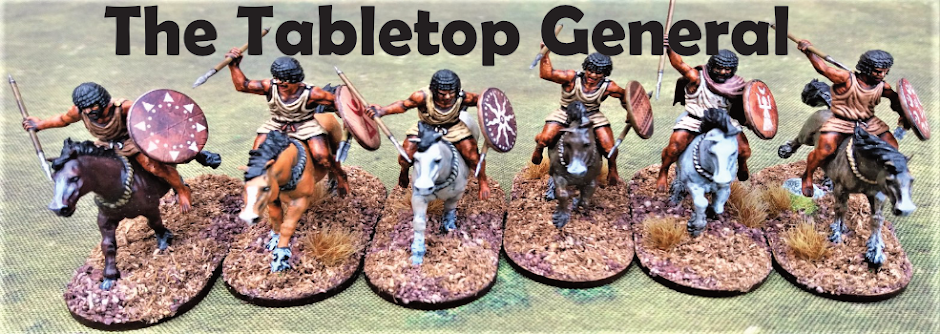Earlier this year, I bought and downloaded a PDF copy of the Knyghte, Pyke and Sworde rule set from Nordic Weasel Games. The rules are a massed Dark Age and Early Medieval skirmish set, which are aimed at games with as few as half a dozen figures, or up to around thirty odd, per side.
The rule set seemed ideal for small games set in the 12th Century, which gave me the opportunity to paint up some Fireforge Medieval figures I had collecting dust at the back of a cupboard in the garage. I'd been reading about the Great Rebellion of 1173, where Henry II found himself beset by a revolt led by his wife and children, who were supported by the kings of both France and Scotland! With Henry away attempting to put down rebels in Normandy, I developed a "campaign" of sorts involving an avaricious bishop and a "Robin Hood" sort of character intent on upholding the law of the beleaguered monarch.
After a couple of small scale trial games, I was coming to the conclusion that, although I really enjoyed the rules, there were aspects which I really felt the need to tinker with, to make them fit the specific needs of my 12th century scenario.
Most obvious, was the activation system, which, in the original rules, follows an alternating turn sequence. Because I was playing solo games, something more random and out of my control was necessary. To achieve this, I decided to introduce a card activation system and made a card set with cards displaying the different troop types deployed on the table top. When a particular troop type card was drawn, a unit of that type could be activated, but any unit could only be activated once per turn. Each side had cards of a different colour, which introduced a little tension as each card was drawn from the deck.
To add a little extra mystery, I also included two other cards; a "temps passe" card, which ends the turn and a "bol de porry" card which can result in an individual or a group possibly missing a turn or having to take a Bravery Test. Drawing either of these cards can put a real spanner in the works and drive a cart and bullock right through your best laid plans!
A pretty major deviation from the original rules in my games, are the classifications of the troops which appear on the battlefield. When I thought about the types of troops I needed to fight my 12th century skirmishes, I arrived at a list of 7 different classes:
1. Armed Peasants (these replaced Rabble)
2. Fyrd (these are the equivalent of Levy)
3. Spearmen (these replaced Shields)
4. Archers (these replaced Missiles)
5. Crossbowmen (these are a variation of Missiles)
6. Men-at-Arms (these are a variation of Chargers)
7. Hero (all individual figures are Heroes and one of them is designated the warband leader)
All of these classes are pretty much the same as their original KPS counterparts, but I have made slight alterations to their characteristics to fit in with the most radical tinker that I made.
One of the problems I found with KPS was that the combat system was based too heavily on the random die roll. I had two occasions where "Rabble" unrealistically out performed characters or groups of higher ability and so I switched the emphasis away from that initial die roll. In its place I created a "Dice Roll Modifier Table", on which, the randomiser was based upon the fighting skill of the figure in the melee.
My adapted combat system now starts with "Combat Skill", adds the modifier from the table and any "Situational Modifiers" which apply.The die roll modifier gives a more balanced outcome to combats, without making it impossible for the lowliest peasant to get the better of a well armed and armoured Man-at-Arms... especially if the peasant teams up with a buddy and they are defending an obstacle! However, the longer the melee goes on, the more likely it is that the feudal superior will get the upper hand.
The final tweak to the KPS system was one of simple semantics; it seemed to me that the term "Exhausted" was just a tad extreme for the circumstances in the game where it applies. Although I would be exhausted after running 5 inches, I thought the lean and athletic characters fighting for King and Country in KPS might get "fatigued" after a bit of a run, but not "exhausted". I really like the way "Fatigue" is used in Clash of Spears, so it should be feasible to create something similar in KPS, which would add more flexibility to the way "fatigue" impacts on the actions figures make in the game.
Having said all this, it may appear that KPS is a system which doesn't work, and that is far from being the case. KPS works brilliantly and gives a really fun and exciting skirmish game. Because I was attempting to create a specific campaign based around specific historic events, it seemed to me a legitimate excuse to adjust the mechanics of the game slightly to create a greater period feel. The use of "Fyrd" for example, rather than "Levy", is, in my opinion, legitimate because "Fyrd" was still a term used at the time, until it fell into disuse after Henry II's Assize of Arms in 1181. The adoption of the Die Roll table gives a less random outcome to combat, particularly between the extremes of the feudal array.
I have plenty more battles to come using these Tinkered KPS rules, where hopefully, the Armed Peasants of Palatine County Durham will still be able to perform their acts of derring-do and the knights and men-at-arms will also be able to show off their particular set of combat skills.




















































